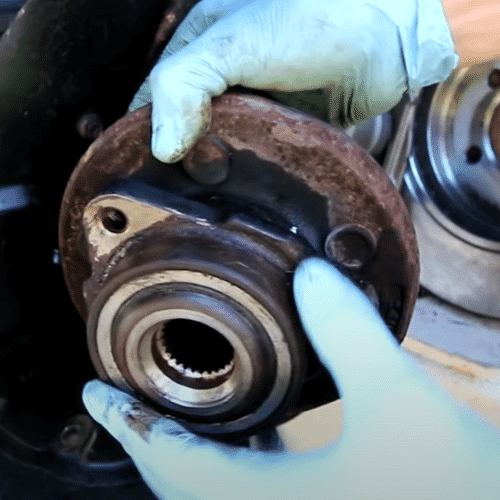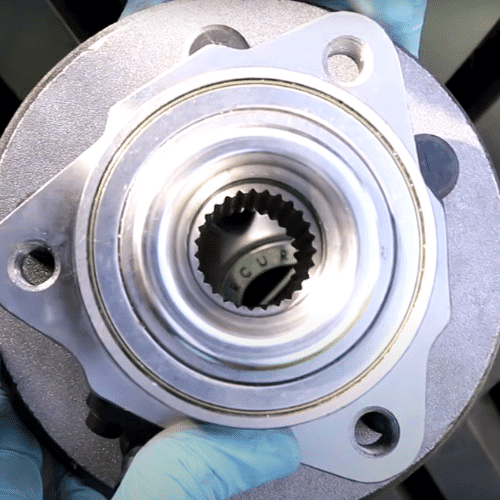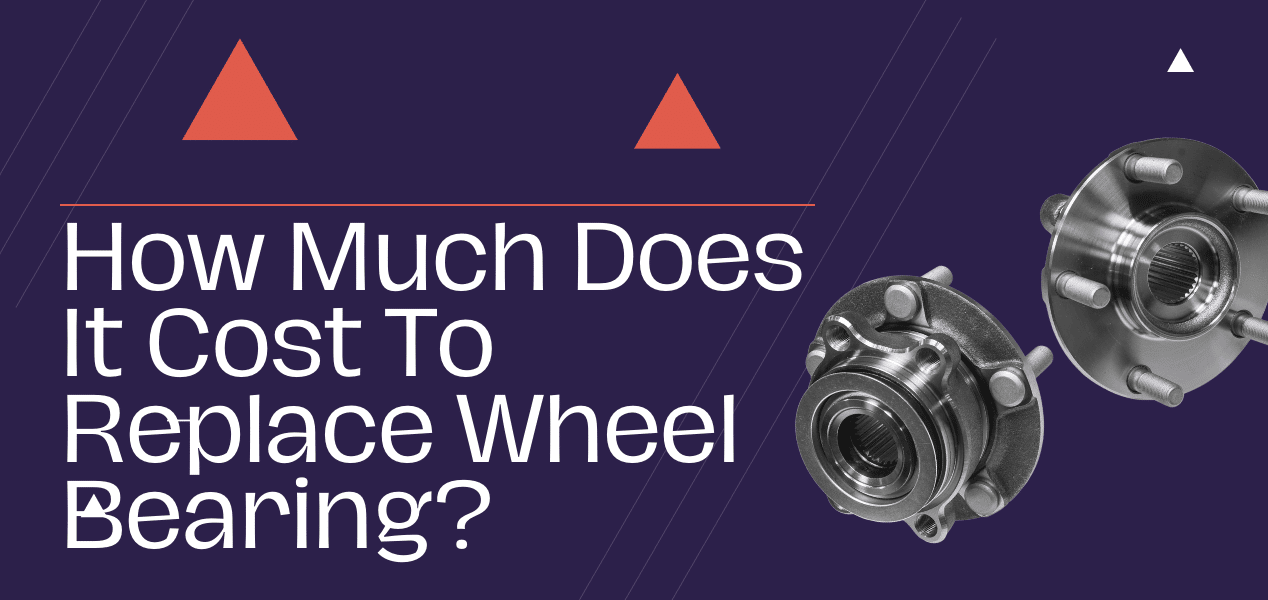Wheel bearings, just like any of your vehicle’s parts, can wear down at a certain point. And when they do wear down, the wheel that it is attached to can suddenly stop during driving. In the worst case, the wheel can fall off! Therefore, it requires replacement. So, how much does it cost to replace wheel bearing?
Cost To Replace Wheel Bearing
The average cost to replace wheel bearings is around $350. However, the cost highly depends on the type of wheel bearing that your vehicle has. For example, if your car has a traditional cone-bearing, you will be looking to spend anywhere from $6 to $20 per bearing.
In other words, wheel bearing replacement costs depend on your vehicle’s type of wheel bearing. And if you want to know the replacement cost of each wheel bearing, continue reading.
Replacement Cost for Every Type of Wheel Bearing
So, regarding the wheel bearing replacement cost, you need to consider two things. The first is the wheel bearings cost, and the second is the labor costs.
While the service cost takes up most of the bill, wheel bearings generally cost under $100. Let’s take a look at the details:
For Replacing Front-Wheel Bearings


The front-wheel bearings come in two different styles. And there are two distinct categories for each of the styles.
Replacement Cost for Tradition Cone or Roller Bearings
The price of replacing roller or traditional wheel bearings will depend on whether you have a 2WD or 4WD.
- 2WD (Two Wheel Drive)
Let us first talk about two-wheel drive vehicles. The 2WD that utilizes traditional cone or roller wheel bearings is pretty dated. But the good news is that you can still replace the bad wheel bearing of these vehicles.
Traditional wheel bearings are not only easy to find but also easy to replace. Due to that reason, you can expect to pay anywhere from $6 to $20 for each replacement wheel bearing.
The labor cost is pretty affordable as well. Your local repair shop should charge anywhere from $80 to $100 for the service. That brings the total to up to $120, which should not put a dent in your wallet.
- 4WD (Four Wheel Drive)
Four-wheel drive vehicles mostly utilize hub systems. And inside the hub assembly, there are cone-style or roller bearings. Just like the wheel bearings for the 2WD vehicles, getting new wheel bearings for 4WD will not cost you much. They reside in the same price range.
Although the new bearings are not costly, the labor cost can increase your total bill. Why so? Setting a new wheel bearing in a 4WD is not easy. Most importantly, working with the wheel hub assembly is a bit tricky. You will need to rely on an extremely professional mechanic.
Also, the mechanic might need to put in 1 to 1.5 hours for each side of the wheel hub assembly. And the labor cost for each hour can be anywhere from $80 to $160. So, if the mechanic needs to work with the entire wheel hub, the total bill easily be a couple of hundred.
Replacement cost for hub-style front wheel bearings
For the hub-style front wheel bearings, you need to consider whether the vehicle is using a complete unit or a pressed-on unit. The cost to replace bad wheel bearings in each is a little different. Let us explain:
- Complete units
Most of the vehicles use a complete unit hub bearing. Dealing with these bad bearings can make your wallet hurt a little. Generally, you can expect to pay anywhere between $80 to $300 to replace each bad wheel bearing.
You should also consider that most of these hub assembly features ABS sensors. So, the mechanic will need to put in a good amount of time to replace this wheel bearing.
Again, the labor cost for each hour is anywhere from $80 to $200. So, if the mechanic has to put two hours on the entire hub, that is about $400 on the bill.
- Pressed-on units
The press-on units are pretty popular among Japanese and German vehicles. As the name suggests, these have pressed-on wheel bearings. Typically, the manufacturers will use roller bearings. Do not confuse them with roller skate wheels, though. Those are totally different.
Nonetheless, for press-on units, mechanics need to put in 2 to 4 hours of work. That translates to anywhere from $160 to $400 for just the labor cost. And the replacement cost for each front wheel bearing unit is between $25 to $50.
Wondering why the mechanic needs to put so much work into these bad wheel bearings? To get to this type of bad wheel bearings, the mechanic needs to remove the entire steering knuckle. And that takes a lot of time and effort.
For Replacing Rear-Wheel Bearings
Unlike front wheel bearing units, there are not many categories for the rear wheel. Here is a brief description of each:
- For Replacing Typical Units
For replacing a wheel bearing from the rear wheel, mechanics must go through a similar procedure to the front wheels. This statement is especially true for the typical units. Most often, the mechanic will need to work with the entire wheel bearing assembly. And as you know, that can take up to 4 hours.
You should also note that some car models will utilize a different style of bearing. And depending on the car model, you will be looking to spend somewhere around $100 for the replacement unit.
- For Replacing the Rear Drive Axle
Most of the old RWD (Rear Wheel Drive) cars and modern vans and trucks will have wheel bearings in the axle. And most will be pressed into the drive axle or the axle tube.
No matter what the case is, to replace wheel bearings that are in the drive axle, you can expect to pay $25 to $50 for each bad wheel bearing. Moreover, do not forget to add the labor cost to the wheel bearing replacement cost!
To replace a wheel bearing on the rear wheel, mechanics need to put anywhere from 1 to 4 hours. And for each hour, they can charge you $80 to $160. Yeah, the rear wheel bearing issue can definitely make you spend a good chunk of your savings.
When Should You Get The Wheel Bearing Replacement?
As you can see, wheel bearing replacements are not cheap. But the thing is, worn-out wheel bearings only require replacement when the condition is too severe.
And when it comes to settling on whether you need to replace a wheel bearing or not, you need to look for these signs:
- Uneven Tire Wear
You can be somewhat sure that it is time to get a wheel bearing replacement when the tire wear is inconsistent. Basically, when the wheel bearings wear out substantially, they tend to make the affected tire wear unevenly.
Remember, in normal conditions, uneven tire wear is not something you will need to worry about. But that does not mean that uneven tire wear only happens when the corresponding wheel bearing is in a rough condition.
You can get irregular tire wear when there are unbalanced tires or off-wheel alignment. So, before settling for a wheel bearing replacement, check whether the other signs match.
- Grinding Noise Coming from the Wheels
When the wheel bearings are in critical condition, the tire will start to make a grinding noise. All the wheel bearings have some form of lubrication in them. And when the wheel bearings are out of lube, the metals start to grind. This eventually causes an old bearing to create loud noises.
Now, this sound will only come from the worn wheel bearing. And it is surely possible to have only one bad bearing in the wheel assembly. So, to pinpoint which wheel bearing has got bad, consider focusing on the wheel that is creating the sound.
- Steering Wheel Vibrations
When the condition of a wheel bearing gets extremely bad, the steering wheel can start to vibrate. This steering wheel vibration will be noticeable when driving at a low speed. And when you step on the pedal, you will feel it.
Many motorists think that the problem is related to unbalanced tires. Although it is a symptom of that issue, vibrations in the steering wheel only happen when the speed is high. Keep this fact in mind when you are trying to figure out whether you need a wheel bearing replacement.
- Excess Wobble in The Wheels
A bad wheel bearing will not generally result in a wobbly wheel. However, a damaged wheel bearing can sometimes introduce a lot of play in the wheels.
To get to the bottom of the issue, lift the vehicle up with jack stands. While the vehicle is lifted, grab one wheel and try to rock it back and forth. Check how much movement the wheel has. Do this for all the wheels of your vehicle.
If the wheel bearing is at a complete failure point, there will be way too much movement.
- Vehicle Tends to Pull on One Side
In a bad wheel bearing, there is no smooth lining. Instead, the lining becomes rough, which causes vibrations in the tire. At moderate speed, this vibration can make your vehicle pull one side. And you probably know what can happen when a vehicle pulls to a particular side. You basically will not have the right level of control.
This pulling problem is also noticeable when braking. And while many blame bad brake rotors or hub assemblies, this sign is basically telling you to get a new bearing.
Different Types of Wheel Bearings Explained
So, vehicles utilize different types of bearings. And if you are thinking of getting a wheel bearing replacement, you should have a fair idea about each of them.
- Ball Bearings
Ball bearings are the most common type of wheel bearings out there. These are the most versatile type of bearing too. As the name suggests, there are balls inside the wheel bearings. These balls can absorb the radial load and thrust load.
What is thrust load? It is the cornering pressure. On the other hand, the weight on the wheel is radial load.
- Precision Ball Bearings
To have a rough idea about precision bearings, you can think of them as revamped ball bearings. These are most suitable for applications where high performance is a necessity.
- Roller Bearings
These types of wheel bearings are pretty too. However, unlike ball bearings, roller bearings are not highly versatile. The typical use case for these is for handling weight properly. And these are not the best overall option in terms of handling cornering pressures.
- Tapered Roller Bearings
Most of the wheels of the trucks have tapered roller bearings. The good thing about them is that they can cut down the friction that occurs when cornering, which they gain from their cone shape.
How To Replace A Front Wheel Bearing
Frequently Asked Questions
Can I replace the wheel bearings by myself?
You can definitely replace the wheel bearings yourself. By doing so, you will significantly lower the wheel bearing replacement cost. However, make sure you have all the specialized tools with you.
How long does it take to replace wheel bearings?
Depending on your experience, you can finish the replacement task in just four hours. However, if it is your first time, it can take 6 hours or more.
How safe is it to drive with a bad wheel bearing?
Not at all; you shouldn’t drive with a bad wheel bearing. The wheel can stop at any given time, which can cause a fatal accident. Also, a wheel with a bad wheel bearing can come off while driving. That will not only damage your vehicle but can also cause a serious accident.
How long do new wheel bearings last?
The lifespan of wheel bearings is anywhere from 85 thousand to 100 thousand miles. However, wheel bearings can wear out before they hit the 85 thousand miles mark. It basically depends on the driving conditions.
What things degrade wheel bearings?
Road debris, such as metallic flakes, dirt, and other tiny particles, can get stuck to the wheel bearing. And when they attach themselves to the wheel bearings, they will cause too much friction.
Final Words
So, how much does it cost to replace wheel bearing? Well, the cost will depend on your car type and what bearing it uses. Luxury cars will have large bills, while regular vehicles will have a lower overall bill. However, the average cost is around $350, including the replacement and service costs.
More Maintenance Posts
Temporary Fix For Bad O2 Sensor

